
تاريخ الفيزياء

علماء الفيزياء


الفيزياء الكلاسيكية

الميكانيك

الديناميكا الحرارية


الكهربائية والمغناطيسية

الكهربائية

المغناطيسية

الكهرومغناطيسية


علم البصريات

تاريخ علم البصريات

الضوء

مواضيع عامة في علم البصريات

الصوت


الفيزياء الحديثة


النظرية النسبية

النظرية النسبية الخاصة

النظرية النسبية العامة

مواضيع عامة في النظرية النسبية

ميكانيكا الكم

الفيزياء الذرية

الفيزياء الجزيئية


الفيزياء النووية

مواضيع عامة في الفيزياء النووية

النشاط الاشعاعي


فيزياء الحالة الصلبة

الموصلات

أشباه الموصلات

العوازل

مواضيع عامة في الفيزياء الصلبة

فيزياء الجوامد


الليزر

أنواع الليزر

بعض تطبيقات الليزر

مواضيع عامة في الليزر


علم الفلك

تاريخ وعلماء علم الفلك

الثقوب السوداء


المجموعة الشمسية

الشمس

كوكب عطارد

كوكب الزهرة

كوكب الأرض

كوكب المريخ

كوكب المشتري

كوكب زحل

كوكب أورانوس

كوكب نبتون

كوكب بلوتو

القمر

كواكب ومواضيع اخرى

مواضيع عامة في علم الفلك

النجوم

البلازما

الألكترونيات

خواص المادة


الطاقة البديلة

الطاقة الشمسية

مواضيع عامة في الطاقة البديلة

المد والجزر

فيزياء الجسيمات


الفيزياء والعلوم الأخرى

الفيزياء الكيميائية

الفيزياء الرياضية

الفيزياء الحيوية

الفيزياء العامة


مواضيع عامة في الفيزياء

تجارب فيزيائية

مصطلحات وتعاريف فيزيائية

وحدات القياس الفيزيائية

طرائف الفيزياء

مواضيع اخرى
Anomalous refraction
المؤلف:
Richard Feynman, Robert Leighton and Matthew Sands
المصدر:
The Feynman Lectures on Physics
الجزء والصفحة:
Volume I, Chapter 33
2024-03-24
1684
The last polarization effect we shall consider was actually one of the first to be discovered: anomalous refraction. Sailors visiting Iceland brought back to Europe crystals of Iceland spar (CaCO3) which had the amusing property of making anything seen through the crystal appear doubled, i.e., as two images. This came to the attention of Huygens, and played an important role in the discovery of polarization. As is often the case, the phenomena which are discovered first are the hardest, ultimately, to explain. It is only after we understand a physical concept thoroughly that we can carefully select those phenomena which most clearly and simply demonstrate the concept.
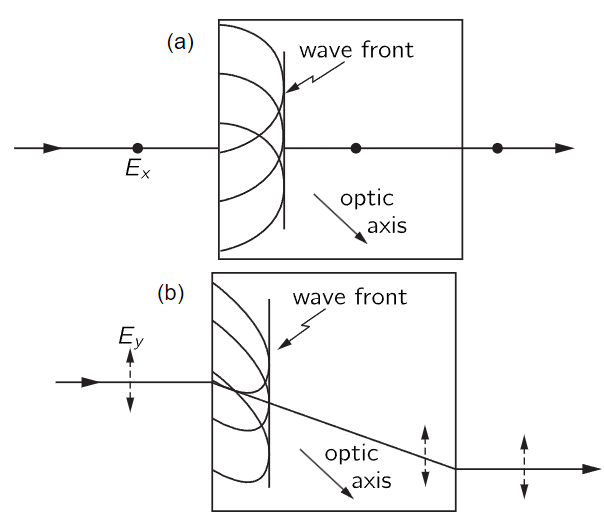
Fig. 33–7. Part (a) of the diagram shows the path of the ordinary ray through a doubly refracting crystal. The extraordinary ray is shown in part (b). The optic axis lies in the plane of the paper.
Anomalous refraction is a particular case of the same birefringence that we considered earlier. Anomalous refraction comes about when the optic axis, the long axis of our asymmetric molecules, is not parallel to the surface of the crystal. In Fig. 33–7 is drawn two pieces of birefringent material, with the optic axis as shown. In part (a) of the figure, the incident beam falling on the material is linearly polarized in a direction perpendicular to the optic axis of the material. When this beam strikes the surface of the material, each point on the surface acts as a source of a wave which travels into the crystal with velocity v⊥, the velocity of light in the crystal when the plane of polarization is normal to the optic axis. The wavefront is just the envelope or locus of all these little spherical waves, and this wavefront moves straight through the crystal and out the other side. This is just the ordinary behavior we would expect, and this ray is called the ordinary ray.
In part (b) of the figure the linearly polarized light falling on the crystal has its direction of polarization turned through 90∘, so that the optic axis lies in the plane of polarization. When we now consider the little waves originating at any point on the surface of the crystal, we see that they do not spread out as spherical waves. Light travelling along the optic axis travels with velocity v⊥ because the polarization is perpendicular to the optic axis, whereas the light travelling perpendicular to the optic axis travels with velocity v∥ because the polarization is parallel to the optic axis. In a birefringent material v∥≠v⊥, and in the figure v∥<v⊥. A more complete analysis will show that the waves spread out on the surface of an ellipsoid, with the optic axis as major axis of the ellipsoid. The envelope of all these elliptical waves is the wavefront which proceeds through the crystal in the direction shown. Again, at the back surface the beam will be deflected just as it was at the front surface, so that the light emerges parallel to the incident beam, but displaced from it. Clearly, this beam does not follow Snell’s law, but goes in an extraordinary direction. It is therefore called the extraordinary ray.
When an unpolarized beam strikes an anomalously refracting crystal, it is separated into an ordinary ray, which travels straight through in the normal manner, and an extraordinary ray which is displaced as it passes through the crystal. These two emergent rays are linearly polarized at right angles to each other. That this is true can be readily demonstrated with a sheet of polaroid to analyze the polarization of the emergent rays. We can also demonstrate that our interpretation of this phenomenon is correct by sending linearly polarized light into the crystal. By properly orienting the direction of polarization of the incident beam, we can make this light go straight through without splitting, or we can make it go through without splitting but with a displacement.
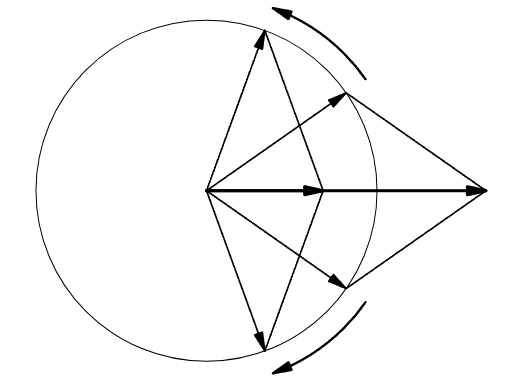
Fig. 33–8. Two oppositely rotating vectors of equal amplitude add to produce a vector in a fixed direction, but with an oscillating amplitude.
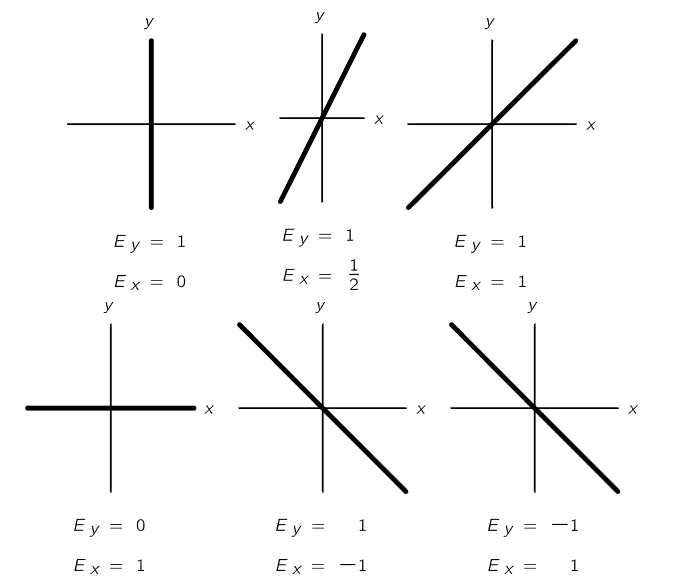
Fig. 33–1. Superposition of x-vibrations and y-vibrations in phase.
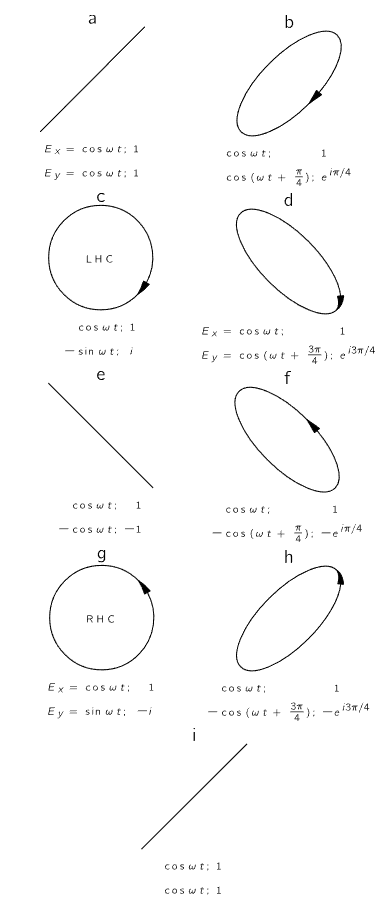
Fig. 33–2. Superposition of x-vibrations and y-vibrations with equal amplitudes but various relative phases. The components Ex and Ey are expressed in both real and complex notations.
We have represented all the various polarization cases in Figs. 33–1 and 33–2 as superpositions of two special polarization cases, namely x and y in various amounts and phases. Other pairs could equally well have been used. Polarization along any two perpendicular axes x′, y′ inclined to x and y would serve as well [for example, any polarization can be made up of superpositions of cases (a) and (e) of Fig. 33–2]. It is interesting, however, that this idea can be extended to other cases also. For example, any linear polarization can be made up by superposing suitable amounts at suitable phases of right and left circular polarizations [cases (c) and (g) of Fig. 33–2], since two equal vectors rotating in opposite directions add to give a single vector oscillating in a straight line (Fig. 33–8). If the phase of one is shifted relative to the other, the line is inclined. Thus, all the pictures of Fig. 33–1 could be labeled “the superposition of equal amounts of right and left circularly polarized light at various relative phases.” As the left slips behind the right in phase, the direction of the linear polarization changes. Therefore, optically active materials are, in a sense, birefringent. Their properties can be described by saying that they have different indexes for right- and left-hand circularly polarized light. Superposition of right and left circularly polarized light of different intensities produces elliptically polarized light.
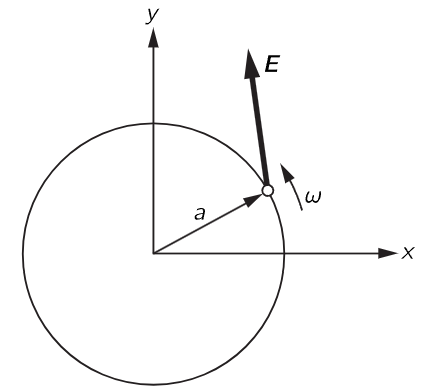
Fig. 33–9. A charge moving in a circle in response to circularly polarized light.
Circularly polarized light has another interesting property—it carries angular momentum (about the direction of propagation). To illustrate this, suppose that such light falls on an atom represented by a harmonic oscillator that can be displaced equally well in any direction in the plane xy. Then the x-displacement of the electron will respond to the Ex component of the field, while the y-component responds, equally, to the equal Ey component of the field but 90∘ behind in phase. That is, the responding electron goes around in a circle, with angular velocity ω, in response to the rotating electric field of the light (Fig. 33–9). Depending on the damping characteristics of the response of the oscillator, the direction of the displacement a of the electron, and the direction of the force qeE on it need not be the same but they rotate around together. The E may have a component at right angles to a, so work is done on the system and a torque τ is exerted. The work done per second is τω. Over a period of time T the energy absorbed is τωT, while τT is the angular momentum delivered to the matter absorbing the energy. We see therefore that a beam of right circularly polarized light containing a total energy E carries an angular momentum (with vector directed along the direction of propagation) E/ω. For when this beam is absorbed that angular momentum is delivered to the absorber. Left-hand circular light carries angular momentum of the opposite sign, −E/ω.
 الاكثر قراءة في مواضيع عامة في علم البصريات
الاكثر قراءة في مواضيع عامة في علم البصريات
 اخر الاخبار
اخر الاخبار
اخبار العتبة العباسية المقدسة

الآخبار الصحية















 "المهمة".. إصدار قصصي يوثّق القصص الفائزة في مسابقة فتوى الدفاع المقدسة للقصة القصيرة
"المهمة".. إصدار قصصي يوثّق القصص الفائزة في مسابقة فتوى الدفاع المقدسة للقصة القصيرة (نوافذ).. إصدار أدبي يوثق القصص الفائزة في مسابقة الإمام العسكري (عليه السلام)
(نوافذ).. إصدار أدبي يوثق القصص الفائزة في مسابقة الإمام العسكري (عليه السلام) قسم الشؤون الفكرية يصدر مجموعة قصصية بعنوان (قلوب بلا مأوى)
قسم الشؤون الفكرية يصدر مجموعة قصصية بعنوان (قلوب بلا مأوى)


















